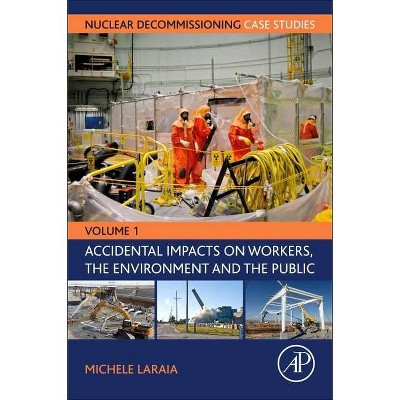A Skeptic's Case for Nuclear Disarmament - by Michael E O'Hanlon (Paperback)

Similar Products
Products of same category from the store
AllProduct info
<p/><br></br><p><b> About the Book </b></p></br></br><p>In 2007 two former U.S. secretaries of state, a defense secretary, and a former senator wrote persuasively in the <i>Wall Street Journal</i> that the time had come to move seriously toward a nuclear-free world. Almost two years later, the Global Zero movement was born with its chief aim to rid the world of such weapons once and for all by 2030.</p> <p>But is it realistic or even wise to envision a world without nuclear weapons? More and more people seem to think so. Barack Obama has declared America's commitment to seek the peace and security of a world without nuclear weapons. But that is easier said than done. Michael O'Hanlon places his own indelible stamp on this critical issue, putting forth a friendly skeptic's case for nuclear disarmament.</p> <p>Calls to ban the bomb are as old as the bomb itself, but the pace and organization of nonproliferation campaigns have picked up greatly recently. The growing Global Zero movement, for example, wants treaty negotiations to begin in 2019. Would this be prudent or even feasible in a world that remains dangerous, divided, and unpredictable? After all, America's nuclear arsenal has been its military trump card for much of the period since World War II. Pursuing a nuclear weapons ban prematurely or carelessly could alarm allies, leading them to consider building their own weapons--the opposite of the intended effect.</p> <p>O'Hanlon clearly presents the dangers of nuclear weapons and the advantages of disarmament as a goal. But even once an accord is in place, he notes, temporary suspension of restrictions may be necessary in response to urgent threats such as nuclear cheating or discovery of an advanced biological weapons program. To take all nuclear options off the table forever strengthens the hand of those that either do not make that pledge or do not honor it. For the near term, traditional approaches to arms control, including dismantling existing bomb inventories, can pave the way to make a true nonprol<p/><br></br><p><b> Book Synopsis </b></p></br></br><p>In 2007 two former U.S. secretaries of state, a defense secretary, and a former senator wrote persuasively in the <i>Wall Street Journal</i> that the time had come to move seriously toward a nuclear-free world. Almost two years later, the Global Zero movement was born with its chief aim to rid the world of such weapons once and for all by 2030.</p> <p>But is it realistic or even wise to envision a world without nuclear weapons? More and more people seem to think so. Barack Obama has declared America's commitment to seek the peace and security of a world without nuclear weapons. But that is easier said than done. Michael O'Hanlon places his own indelible stamp on this critical issue, putting forth a friendly skeptic's case for nuclear disarmament.</p> <p>Calls to ban the bomb are as old as the bomb itself, but the pace and organization of nonproliferation campaigns have picked up greatly recently. The growing Global Zero movement, for example, wants treaty negotiations to begin in 2019. Would this be prudent or even feasible in a world that remains dangerous, divided, and unpredictable? After all, America's nuclear arsenal has been its military trump card for much of the period since World War II. Pursuing a nuclear weapons ban prematurely or carelessly could alarm allies, leading them to consider building their own weapons--the opposite of the intended effect.</p> <p>O'Hanlon clearly presents the dangers of nuclear weapons and the advantages of disarmament as a goal. But even once an accord is in place, he notes, temporary suspension of restrictions may be necessary in response to urgent threats such as nuclear cheating or discovery of an advanced biological weapons program. To take all nuclear options off the table forever strengthens the hand of those that either do not make that pledge or do not honor it. For the near term, traditional approaches to arms control, including dismantling existing bomb inventories, can pave the way to make a true nonproliferation regime possible in the decades ahead.</p><p/><br></br><p><b> Review Quotes </b></p></br></br><br><P>" "A Skeptic's Case for Nuclear Disarmament" is a thoughtful exploration of key issues that citizens and government officials should evaluate prior to deciding whether to pursue the elimination of nuclear weapons. Michael O'Hanlon analyzes these questions in a fair and balanced way, presenting the arguments on both sides and drawing his own conclusions. The book is an important contribution to the continuing debate on the roles of nuclear weapons in international security and the risks run by all nations by their continued existence."--Barry M. Blechman, Distinguished Fellow, Henry L. Stimson Center<br><br><P>"No policy debate today is more important than the ongoing debate on the elimination of nuclear weapons. Michael O'Hanlon takes a clear, analytical look at the implications of nuclear disarmament. He argues that abolition is impractical, but that dismantlement of all nuclear weapons is imperative. His book makes a major contribution to this vital issue."--William J. Perry, former U.S. Secretary of Defense<br><p/><br></br><p><b> About the Author </b></p></br></br><p> <b>Michael E. O'Hanlon</b> is a senior fellow and the director of research in Foreign Policy at the Brookings Institution, where he holds the Sydney Stein Jr. Chair. He is the author of numerous books, including <i>Toughing It Out in Afghanistan</i>, with Hassina Sherjan (Brookings, 2010), <i>The Science of War</i> (Princeton University Press, 2009), and <i>Hard Power: The New Politics of National Security</i>, with Kurt Campbell (Basic Books, 2006). He is also senior author of the Brookings Afghanistan, Iraq, and Pakistan indexes.</p>
Price History
Price Archive shows prices from various stores, lets you see history and find the cheapest. There is no actual sale on the website. For all support, inquiry and suggestion messagescommunication@pricearchive.us




















